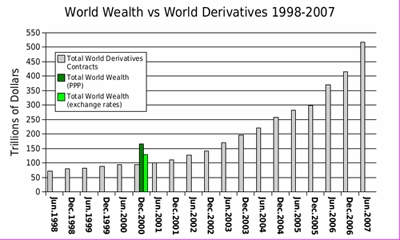The “mortgage crisis” basically came about because Congress repealed the Glass–Steagall Act of 1933 (officially called the Banking Act of 1933), which separated the commercial banking business (deposits) from investment banking (securitization).
The notorious bill repealing Glass–Steagall, pushed by the banking industry and called the Gramm-Leach-Bliley Act, was voted on strictly by party lines, and signed into law by President Clinton in 1999. This bill basically destroyed the remaining firewall between commercial banking and investment banking.
Why was this firewall so important?
Well, a commercial bank (before Gramm–Leach–Bliley) accepted deposits but could not engage in securitization. Securitization is the process of pooling and repackaging of cash–flow–producing financial assets into securities, which are then sold to investors.
An asset is something that produces income; like a stock, a bond, or a mortgage. A stock produces dividends for the owner of the stock, based on the productive capacity of the issuing corporation or business entity. A bond yields a fixed rate of interest, again derived from the income producing activities of the underlying business. And a mortgage also produces income for the issuing bank, as people work and make their monthly payments.
Under Glass–Steagall, a commercial bank made money through its lending activities. If a bank granted a mortgage (or any loan) to an unqualified customer and that customer defaulted, the bank lost out. It could not collect interest on that loan, and had to write it off. Therefore, it was in the best interest of a bank to thoroughly research and validate every person or institution to whom it lent money.
Under Glass–Steagall, the securities industry was regulated by the SEC, the Securities and Exchange Commission. This institution gained respect over the years from 1934 onwards, throughout the world’s financial markets, for its enforcement of the sometimes “Wild West” nature of the securities industry. As a result, investment paper issued by U.S. financial institutions were regarded as solid investments.
However, beginning in the mid 1980’s or so and continuing on in to the 90’s the securities industry began developing new, higher risk investment instruments, and the SEC became less and less able to cope. This new investment climate was also reflected in the passage of the Garn-St. Germain Depository Institutions Act of 1982, which deregulated the Savings and Loan industry, and turned out to be one of many contributing factors that led to the Savings and Loan crisis of the late 1980s. This act also allowed the creation of “adjustable–rate” mortgages.
You probably recall Michael Milken, who single–handedly created the market for “junk bonds” and other higher-risk alternative investments, and who was indicted and sent to prison in 1989. These new financial instruments, called derivatives, were a precursor to the derivatives explosion after 1999. Derivatives are created like a child creates a house of cards, building new and more exotic investment vehicles on top of each other. As time went on, the regulatory agencies (especially the SEC) became emasculated, allowing this process to continue like a cancerous cell multiplies within the body.
Enter Gramm–Leach–Bliley. After 1999, commercial banks were now also able to get into securitization. What happened is that commercial (deposit) banks now saw an opportunity to take advantage of the U.S.’ great financial reputation. Instead of carefully doing their due diligence and only lending to qualified customers, banks sent “mortgage specialists” out to every Tom, Dick, and Harry and gave them loans, knowing that they could simply repackage these mortgages and sell them to third parties, who may not have done their research. Banks were now lending, simply put, to unqualified persons and “banking” on the good reputation of our commercial paper.
In turn, other financial institutions would take those repackaged mortgages and repackage them again. This dicing and slicing and repackaging of mortgages soon got to the point where no one could identify the underlying mortgage assets.
In the securities industry, the same thing goes on all the time. The most important aspect of the securities industry are called derivatives.
What is a derivative?
It is financial instrument based (supposedly) on underlying assets, which are valued (supposedly) according to their market value. The process of evaluation is called “mark to market” and guarantees that an investor understands the value of his purchased investment. However, the derivatives market, especially during the past decade, went totally out of control. More and more exotic financial instruments were created, which became more and more divorced from the underlying assets. It got so bad that the issuer of a financial product simply assigned its own value to the product, based on mathematical formulas, or simply by guess!
Christopher Story, the noted U.K. intelligence and financial analyst and publisher of the respected “International Currency Review,” has stated that “...the notional value of outstanding adjusted global over-the-counter derivatives contracts had expanded from $257,894 billion at the end of 2004, to $596,004 billion by the end of December 2007. The most recent figure cited (applicable to around mid-October 2008) was $667 trillion. But the underlying gross market values of these outstanding contracts rose from just $9,377 billion at the end of December 2004, to $14,522 billion by the end of 2007. Thus, whereas the gross market values of outstanding contracts were ‘worth’ 3.6% of their notional values at the end of 2004, the equivalent proportion three years later was 2.4%.”
(see http://www.worldreports.org for Mr. Story’s reports).
We are all familiar by now of the collapse of the Bernard L. Madoff investment fund. This fund was composed almost exclusively of derivatives.
In its article on “Derivatives,” Wikipedia shows a chart of total world–wide derivatives which corresponds closely with the above. Here it is:

In other words, the “mortgage crisis” is just part of a much larger and deeper financial mess that affects the entire world financial system.
What can be done?
Globally, the world’s economic powers agreed on new banking regulations called “Basel II,’ which forbids off–balance sheet transactions and exotic financial derivatives, and requires that source of funds be identified for every claimed asset. In 2006, funds were also made available (called the Settlements) to refund the dollar and stabilize the world’s financial and banking systems. The United States, however, under the Bush administration, has been furiously attempting to stall the implementation of these needed banking regulations, and has been blocking the Settlements.
Fortunately, our new President has seem the light (we hope) and has appointed Mary Schapiro to be Head of the now discredited US Securities and Exchange Commission (SEC). Apparently, Ms. Schapiro has a very high reputation in financial circles for integrity and intelligence.
The new President has also appointed Peter Orszag to be Director of the Office of Management and Budget (OMB). Mr Orszag has been Director of the Congressional Budget Office, which enjoys a sound reputation, whereas the OMB has, as Mr. Story says, “for decades been engaged in creative accounting, smoke and mirrors obfuscation, and the falsification of the US Federal Budget and background debt data.”
Hopefully this article has given you a little more understanding of the mortgage and financial mess. Remember that the government produces debt, and the private sector produces income and assets. So the solution cannot and must not come from government.
Government can only spend what the private sector produces, through the function of taxation. Because our government has engaged in deficit spending for the past half century, it has accumulated gigantic debts in the range of $11 trillion dollars, and unfunded liabilities in the range of over $50 trillion dollars. Our balance–of–payments deficits with the rest of the world –– the amount we import versus the amount of our exports –– are over $500 billion dollars every year.
According to the Peterson Institute for International Economics, the global current account deficit of the US is presently almost $800 billion, or about 7 percent of US GDP. To finance both the current account deficit and its own sizable foreign investments, we have to import about $1 trillion of foreign capital every year!
In deficit spending, the government must either borrow to fund its deficits, or have the Fed simply create money out of thin air. Either way, we go into more debt and further undermine our economic integrity.
The proper function of government is to regulate the private sector and ensure that it does not go out of control. Unfortunately, it appears that the government wants to solve the financial crisis by micro–managing the economy with its bailouts of insurance companies, banks, and the automobile companies.
Government is inefficient, that is obvious to any rational observer, and is concerned more with protection of vested interests than it is with the good of all the people.. If you think things are badly run now, wait until the government takes complete control of health care, for example. The new health care plans are a gift to big pharmaceutical companies, who are heavy contributors to the political campaigns of our so-called Congressional representatives.
The proper solution to this mess is to downsize government, and governmental interference in the economy, and increase the integrity and rigor of regulatory institutions like the SEC. The financial and mortgage crisis began and spun out of control because we have done just the opposite.
Kenneth MacLean
http://www.kjmaclean.com
http://www.marketingwithspirit.com



